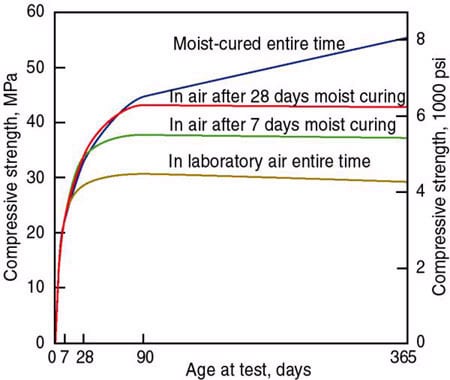Concrete curing time is very similar to the concrete curing method. It is very important to choose the right time to cure concrete and perform the appropriate curing method for the required period.
What is concrete curing?
Curing involves providing sufficient moisture to the surface of the concrete after it has been poured and leveled. This completes the hydration process.
In addition, we carry out curing to control the increase in temperature in large concrete placements due to the heat of hydration.
When concrete is produced in a cold environment, the temperature of the concrete must be increased to complete the hydration process.
When should healing begin?
The start of concrete curing time depends on several factors. Once the concrete is poured, we can begin curing it. However, there are some limitations regarding the curing method.
Some curing methods, such as applying a concrete coating, cannot be performed until the concrete surface has cured to a certain extent.
Water curing can begin immediately after the concrete begins to harden. Therefore, healing time depends on many factors. There are a few factors that determine how long it takes for concrete to dry.
- Moisture in concrete
If the moisture content is higher, the hardening of the concrete will be delayed. The lower the humidity, the faster the curing process.
We have to pay attention to the moisture content. As concrete dries, the moisture content on the surface of the concrete also decreases. In strong winds, concrete dries quickly and this drying can result in shrinkage cracks.
- temperature
Temperature is an indication of how quickly concrete dries. When the ambient temperature is high, concrete dries quickly. This must be monitored and taken into consideration when deciding when to begin healing.
- Mix design
The composition of the mixture significantly influences the concrete hardening time. The curing time can be assessed on site and is the responsibility of the construction manager.
How long does concrete take to cure?
The following number, taken from the internet, indicates the increase in resistance over the healing time.


The summary of this study is as follows.
- When we cure, the strength of the concrete stops increasing above a certain level.
- There is a significant difference between 7 and 28 day aging. However, the difference is constant and not significant.
- When cured for more than a year, there is a very strong increase in strength.
In practice, it is not possible to extend the curing time of concrete by one year. Therefore, we need to agree on choosing the most appropriate curing time.
EU Generally, concrete reaches its highest strength, 70-80% of the characteristic strength, within 7 days after concreting. With this in mind, healing typically takes 7 days.
However, for larger concrete types, such as very large volume concrete, the curing time must be determined based on data obtained from a model test. From this test we can derive the temperature progression over time. If there is no significant drop in temperature after 7 days, the curing time should be increased.
Related articles
- Early thermal cracking (calculate R/F requirements)
- Influence of construction practices on the formation of cracks
- Formation of cracks in concrete (basics, types and causes)
- Physical reasons for cracks
- Basics of crack formation in immature concrete
- Types of Foundation Cracks, Why They Are Serious
- Basement Wall Cracks (A Detailed Study)
- What is concrete spalling – causes and repairs
- 20 factors that affect the durability of concrete
- Durability of concrete (requirements and problems)
- Concrete shaking (methods and correct procedure)
- 6 Factors That Affect Concrete Curing Time
- 11 Methods for Hardening Concrete
- A detailed study of concrete (from scratch)
- Types of concrete shrinkage (detailed study)

